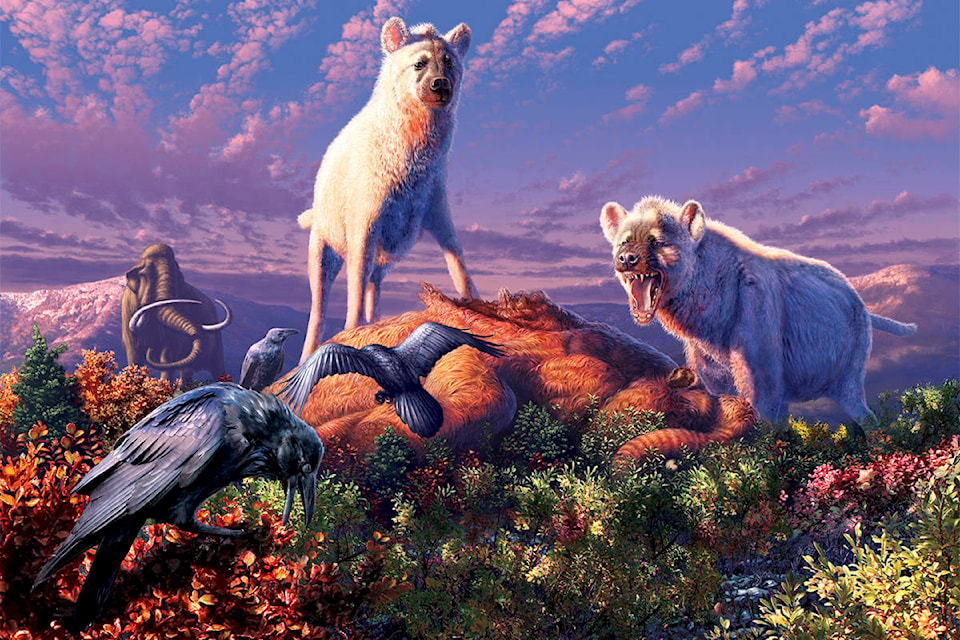A new research paper has determined two fossilized teeth found in the Old Crow region belong to the now-extinct running hyena, thus proving hyenas lived in the Yukon during the ice age.
The paper, which will be published this month in the journal Open Quaternary, explains that hyenas likely arrived in the Yukon from Asia around 4.5 million years ago and then expanded their population as far south as Mexico. They likely went extinct between one million and 500,000 years ago, when the rest of the running hyenas went extinct throughout the continent.
The two fossilized teeth were discovered in 1973 and 1977 and then placed in the collections of the Canadian Museum of Nature in Ottawa. Old Crow is a frequent site of paleontological expeditions — over 50,000 fossils from throughout the region are held in the museum.
“I’ve known for many years of these two strange teeth that were thought to be maybe hyenas, but no one was quite sure,” said Grant Zazula, palaeontologist for the Yukon government and a co-author on the study.
When he last visited the museum this January, he sent a picture of the teeth to Z. Jack Tseng, a palaeontologist from the University at Buffalo and another co-author of the study. Tseng had previously heard of these fossils after reviewing notes discovered by the study’s other co-author, Lars Werdelin, so he drove up to Ottawa to study them.
“When I saw the photos before I saw the actual specimens, I knew almost immediately they belonged to a hyena,” said Tseng.
Through comparing the teeth to those of other hyenas, he concluded they belonged to the hyena species Chasmaporthetes, or running hyenas. They are believed to have travelled from Siberia to North America during the ice age, when sea levels were low enough for animals to be able to cross continents. However, their fossils have only been found in what is now the southern United States and Mexico until now.
“Hyenas are known as fossils all over the old world — Europe, Asia and Africa,” said Tseng. “There were between 60 and 70 (hyena) fossil species known in that area, but there’s only a single species that made it out of the region into North America. So we matched the two teeth to the same species that had been known earlier.”
According to Tseng, the identification of the teeth has led to “more questions than answers,” particularly ones that relate to how they were able to survive the harsh climate. Regardless, the study’s authors have some ideas on how they adapted.
“It would not be out of the question for these Arctic hyenas to have potentially thicker fur or potentially pale fur to camouflage them from prey,” Tseng said.
The Arctic hyenas were also likely very dominant predators when they first emerged.
“They didn’t have competition from the grey wolves (or) lions or bears because those animals didn’t enter North America by that point,” said Zazula. “They were hunting animals like caribou and horses, those that have probably been the two large, dominant herbivores. And also large camels — giant camels were around when these were living here. And then early mammoths.”
The authors are not certain about how they went extinct either. One explanation suggests the appearance stronger predators such as short-faced bears, grey wolves, lions and Borophagus — an extinct form of canid — resulted in the hyenas becoming out-competed for food.
The harsh winter climate may have also contributed to their extinction.
“There were a lot of animals going extinct in general around the globe between the transition from a warmer earth around five million years ago to an ice age earth,” Tseng said. “As the ice age dragged on, maybe that became too harsh for some of these animals to survive in.”
Tseng said there are likely other hyena fossils around Old Crow that, if discovered, could provide more information about how these animals survived in their environment.
“If we find more fossils, we will understand better the potential differences between the Arctic ones and the ones more south. Maybe their leg bones would tell us more about if they’re longer-legged or shorter-legged and whether they had more flexible bodies or not, depending on how they would have adapted to the Arctic environment.”
Zazula will be up in Old Crow this July, and hyena fossils will likely be on his mind. He leads an archaeological expedition throughout the area every summer, and this year he’s leading a team on a 10-day search for fossils along the Old Crow river.
“Every time we go there, there’s always something remarkable that gets found,” he said.
“We never know if we’re going to find a new species or find a new example of a species or maybe we’ll find more hyenas this summer. We never know. So we’re pretty excited — there’s never any shortage of new discoveries from the ice age in the Yukon.”
Contact Joshua Azizi at Joshua.Azizi@yukon-news.com
